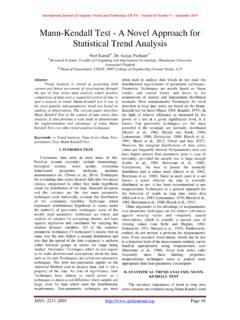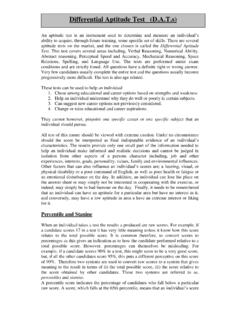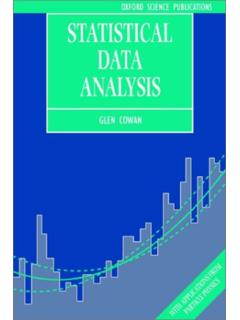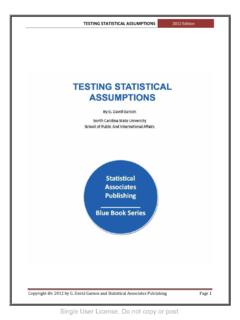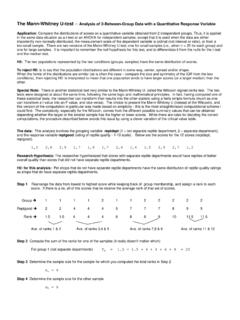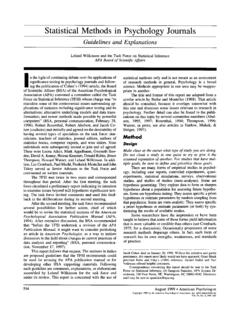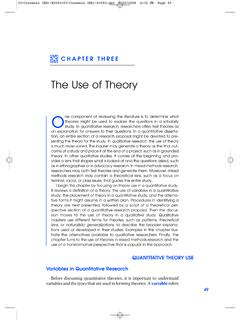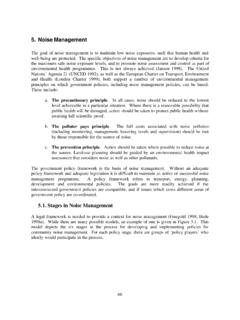Transcription of TI 83/84 Calculator The Basics of Statistical Functions
1 1 TI 83/84 Calculator The Basics of Statistical Functions What you want to do >>> Put Data in Lists Get Descriptive Statistics Create a histogram, boxplot, scatterplot, etc. Find normal or binomial probabilities Confidence Intervals or Hypothesis tests How to start STAT > EDIT > 1: EDIT ENTER [after putting data in a list] STAT > CALC > 1: 1-Var Stats ENTER [after putting data in a list] 2nd STAT PLOT 1:Plot 1 ENTER 2nd VARS STAT > tests What to do next Clear numbers already in a list: Arrow up to L1, then hit CLEAR, ENTER. Then just type the numbers into the appropriate list (L1, L2, etc.) The screen shows: 1-Var Stats You type: 2nd L1 or 2nd L2, etc. ENTER The Calculator will tell you , s, 5-number summary (min, Q1, med, Q3, max), etc.
2 1. Select On, ENTER 2. Select the type of chart you want, ENTER 3. Make sure the correct lists are selected 4. ZOOM 9 The Calculator will display your chart For normal probability, scroll to either 2: normalcdf(, then enter low value, high value, mean, standard deviation; or 3:invNorm(, then enter area to left, mean, standard deviation. For binomial probability, scroll to either 0:binompdf(, or A:binomcdf( , then enter n,p,x. Hypothesis Test: Scroll to one of the following: 1:Z-Test 2:T-Test 3:2-SampZTest 4:2-SampTTest 5:1-PropZTest 6:2-PropZTest C:X2-Test D:2-SampFTest E:LinRegTTest F:ANOVA( Confidence Interval: Scroll to one of the following: 7:ZInterval 8:TInterval 9:2-SampZInt 0:2-SampTInt A:1-PropZInt B:2-PropZIn Other points: (1) To clear the screen, hit 2nd, MODE, CLEAR (2) To enter a negative number, use the negative sign at the bottom right, not the negative sign above the plus sign.)))))
3 (3) To convert a decimal to a fraction: (a) type the decimal; (b) MATH > Frac ENTER 2 Frank s Ten Commandments of Statistics 1. The probability of choosing one thing with a particular characteristic equals the percentage of things with that characteristic. 2. Samples have STATISTICS. Populations have PARAMETERS. 3. Unusual means more than 2 standard deviations away from the mean; usual means within 2 standard deviations of the mean. 4. Or means Addition Rule; and means Multiplication Rule 5. If Frank says Binomial, I say npx. 6. If (sigma/the standard deviation of the population) is known, use Z; if is unknown, use T. 7. In a Hypothesis Test, the claim is ALWAYS about the population.
4 8. In the Traditional Method, you are comparing POINTS (the Test Statistic and the Critical Value); in the P-Value Method, you are comparing AREAS (the P-Value and (alpha)). 9. If the P-Value is less than (alpha), reject H0 ( If P is low, H0 must go ). 10. The Critical Value (point) sets the boundary for (area). The Test Statistic (point) sets the boundary for the P-Value (area). 3 Chapters 3-4-5 Summary Notes Chapter 3 Statistics for Describing, Exploring and Comparing Data Calculating Standard Deviation s = Example: x x (x - )2 1 -5 25 3 -3 9 14 8 64 Total 98 = 6 (18/3) s = = = 7 Finding the Mean and Standard Deviation from a Frequency Distribution Speed Midpoint (x) Frequency (f) x2 f x f x2 42-45 25 46-49 14 665 50-53 7 54-57 3 58-61 1 50 2339 = , so s = , so s = = Percentiles and Values The percentile of value x = (round to nearest whole number) To find the value of percentile k: L =.
5 This gives the location of the value we want; if it s not a whole number, we go up to the next number. If it is a whole number, then the answer is the mean of that number and the number above it. **Using the Calculator : To find mean & standard deviation of a frequency distribution or a probability distribution: First: STAT > EDIT ENTER, then in L1 put in all the x values (midpoints if it s a frequency distribution); in L2 put in frequencies or probabilities as applicable. Second: STAT > CALC ENTER 1-Var Stats 2ND L1, 2ND L2 ENTER. The screen shows the mean ( ) and the standard deviation, either Sx (if it s a frequency distribution) or x (if it s a probability distribution).
6 Chapter 4 - Probability Addition Rule ( OR ) P(A or B) = P(A) + P(B) P(A and B) Find the probability of at least 1 girl out of 3 kids, with boys and girls equally likely. 0 girls) = P(all boys) = .125* P(at least 1 girl) = P(1, 2 or 3 girls) = 1 minus .125 = .875 These are complements, so their combined probability must = 1. Fundamental Counting Rule: For a sequence of two events in which the first event can occur m ways and the second event can occur n ways, the events together can occur a total of m n ways. Factorial Rule: A collection of n different items can be arranged in order n! different ways. ( Calculator Example: To get 4!, hit 4 MATH>PRB>4 ENTER Multiplication Rule ( AND ) P(A and B) = P(A) P(B|A) Conditional Probability P(B|A) = Permutations Rule (Items all Different) 1.
7 N different items available. 2. Select r items without replacement 3. Rearrangements of the same items are considered to be different sequences (ABC is counted separately from CBA) Calculator example: n = 10, r = 8, so 10P8 Hit 10 MATH > PRB > 2, then 8 ENTER = 1814400 Permutations Rule (Some Items Identical) 1. n different items available, and some are identical 2. Select all n items without replacement 3. Rearrangements of distinct items are considered to be different sequences. # of permutations = Combinations Rule 1. n different items available. 2. Select r items without replacement 3. Rearrangements of the same items are considered to be the same sequence (ABC is counted the same as CBA) Calculator example: n = 10, r = 8, so 10C8 Hit 10 MATH > PRB > 3, then 8 ENTER = 45 * All boys means #1 is a boy AND #2 is a boy AND #3 is a boy, so we use the Multiplication Rule.
8 5 x .5 x .5 = .125 4 Formulas for Mean and Standard Deviation All Sample Values Frequency Distribution Probability Distribution Mean Std Dev Chapter 5 - Discrete Probability Distributions Sec. A random variable is simply a number that can change, based on chance. It can either be discrete (countable, like how many eggs a hen might lay), or continuous (like how much a person weighs, which is not something you can count). Example: The number of Mexican-Americans in a jury of 12 members is a random variable; it can be anywhere between 0 and 12. And it is a discrete random variable, because it is a number you can count.
9 To find the mean and standard deviation of a probability distribution by hand, you need 5 columns of numbers: (1) x; (2) P(x); (3) x P(x); (4) x2; (5) x2 P(x). Using the Calculator : To find the mean and standard deviation of a probability distribution, First: STAT > EDIT, then in L1 put in all the x values, and in L2 put in the probability for each x value. Second: STAT > CALC > 1-Var Stats > 1-Var Stats L1, L2 ENTER. Sec. Binomial Probability Requirements ___ Fixed number of trials ___ Independent trials ___ Two possible outcomes ___ Constant probabilities Formulas = n p q = 1 - p Using the Calculator 1. To get the probability of a specific number: 2nd VARS binompdf (n, p, x) (which gives you the probability of getting exactly x successes in n trials, when p is the probability of success in 1 trial).
10 2. To get a cumulative probability: 2nd VARS binomcdf (n, p, x) (which gives you the probability of getting up to x successes in n trials, when p is the probability of success in 1 trial). IMPORTANT: there are variations on this one, which we will talk about. Be sure to get them clear in your mind. At most/less than or equal to: binomcdf(n,p,x) Less than: < binomcdf(n,p,x-1) At least/greater than or equal to: 1 minus binomcdf(n,p,x-1) Greater than/more than: > 1 minus binomcdf(n,p,x) Symbol Summary Sample Population How many? n N Mean Proportion p Standard Deviation s Correlation Coefficient r 5 Chapters 6-7-8 Summary Notes Ch Topic Calculator Formulas, Tables, Etc.


